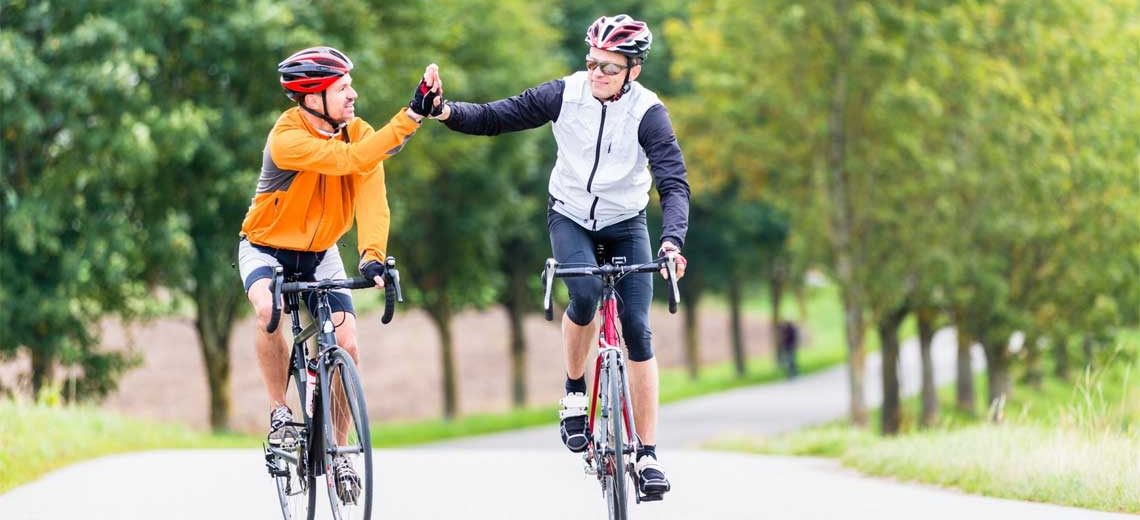Just because snow and ice have emerged on the scene, that doesn’t mean that you have to hang up your bike until springtime. It is definitely possible to get on your bike and ride during wintertime weather, as long as there isn’t so much snow and ice that it becomes impossible or totally unsafe. Part of biking effectively and safely during winter does, however, require specific clothing.
Dressing properly will help you to avoid dehydration, protect your skin from the sun (which is still around and still casting potentially harmful rays), and keep your skin from becoming agitated by the cold. In this article, we’ll give you a few tips to help you stay safe, warm and dry when you break out your bike during the winter season.
What Should You Wear When Bike Riding in Winter?
Dressing properly is the best way that you can safeguard your health when wintertime biking is on the agenda. Here are 6 tips to help you gear up appropriately when the temperatures drop, and snow makes its presence known.
Protect Your Eyes
 Winter winds and whipping snow can seriously impede a person’s ability to see when they are on the biking trail. Also, you’ve probably experienced “snow blindness” if you live in an area that receives any amount of snowfall. Sunlight glinting off the pure, white powder can be dangerous if you’re operating any type of vehicle. Goggles or some type of sunglasses can be called for, depending on the circumstances the person is riding in.
Winter winds and whipping snow can seriously impede a person’s ability to see when they are on the biking trail. Also, you’ve probably experienced “snow blindness” if you live in an area that receives any amount of snowfall. Sunlight glinting off the pure, white powder can be dangerous if you’re operating any type of vehicle. Goggles or some type of sunglasses can be called for, depending on the circumstances the person is riding in.
If you wear prescription eyeglasses, you’ve got little choice but to wear them while riding. Prescription sunglasses can help on those bright, wintry days. But if you’re worried about snow and cold air keeping you from seeing adequately, you may need to wear your personal glasses under a pair of goggles.
Layer Your Clothing
You’re probably already familiar with the concept of layering clothes to keep yourself warm in the winter. But did you know that you can prevent overheating during your bike riding sessions by layering, as well? The physical exertion behind riding can cause you to warm up as the session goes on. The day might warm up, or it might get colder. It always pays to have at least two layers of clothing accessible to you during your ride:
- A warm but lightweight, moisture-wicking layer of clothing that is closest to the skin.
- A wind proof outer layer that will protect your skin from the chill of the winter’s winds.
Being able to remove and put on an added layer of warmth is a very good idea, as you don’t want to compromise your health this way. However, this can be different for ice bikers who go riding on remote trails.
Oftentimes, it is the bottom layer – the moisture wicking layer – that needs to be removed in the winter, not the outer, windproof layer. You’re not going to be wanting to take off all of your layers just to get this one off, not if you don’t have somewhere to change that’s away from the elements. For more casual bikers who have access to spots where they can warm up and take a break, layering can be much more practical.
Wear Headgear
Your head is one of your body’s key radiators of heat, so wearing headgear that covers the top of the head completely can actually help you to regulate your body heat. If you feel that you’re overheating on your ride, you can take off your helmet and allow some of the heat gathered between your scalp and the helmet to dissipate for a moment. A helmet can also help you to stay warm, for the same reason, when the chill starts to get to you.
Don’t Be too Proud
 If you’re newer to wintertime biking, you might not yet know how to read the weather and plan accordingly. After all, nobody is born with this knowledge. Don’t let your pride keep you from backtracking a bit to apply an extra layer or item if it’s necessary. It takes a lot of practice and understanding of the weather to know what to wear instinctively during the winter, so you’re likely to make some wardrobe mistakes at first. And that’s okay!
If you’re newer to wintertime biking, you might not yet know how to read the weather and plan accordingly. After all, nobody is born with this knowledge. Don’t let your pride keep you from backtracking a bit to apply an extra layer or item if it’s necessary. It takes a lot of practice and understanding of the weather to know what to wear instinctively during the winter, so you’re likely to make some wardrobe mistakes at first. And that’s okay!
Choose the Right Materials
When sweat and ice-cold temperatures enter the equation at the same time, it can be difficult to figure out what fabrics are best to wear. While we’ve emphasized the importance of water wicking and windproof layers, there are some “don’ts” that you should keep in mind when choosing your biking winterwear.
- Avoid wearing cotton, especially close to the skin. It absorbs moisture and keeps that moisture next to the skin. When sweat is still on the skin, you will start to freeze the second you take a break or even a small pause.
- Don’t assume that everything has to be labeled as “great for cycling.” Though the market for ice bikers is growing in terms of apparel, there are few clothing items that are marked this way and work in winter. Consider looking at ski clothing.
